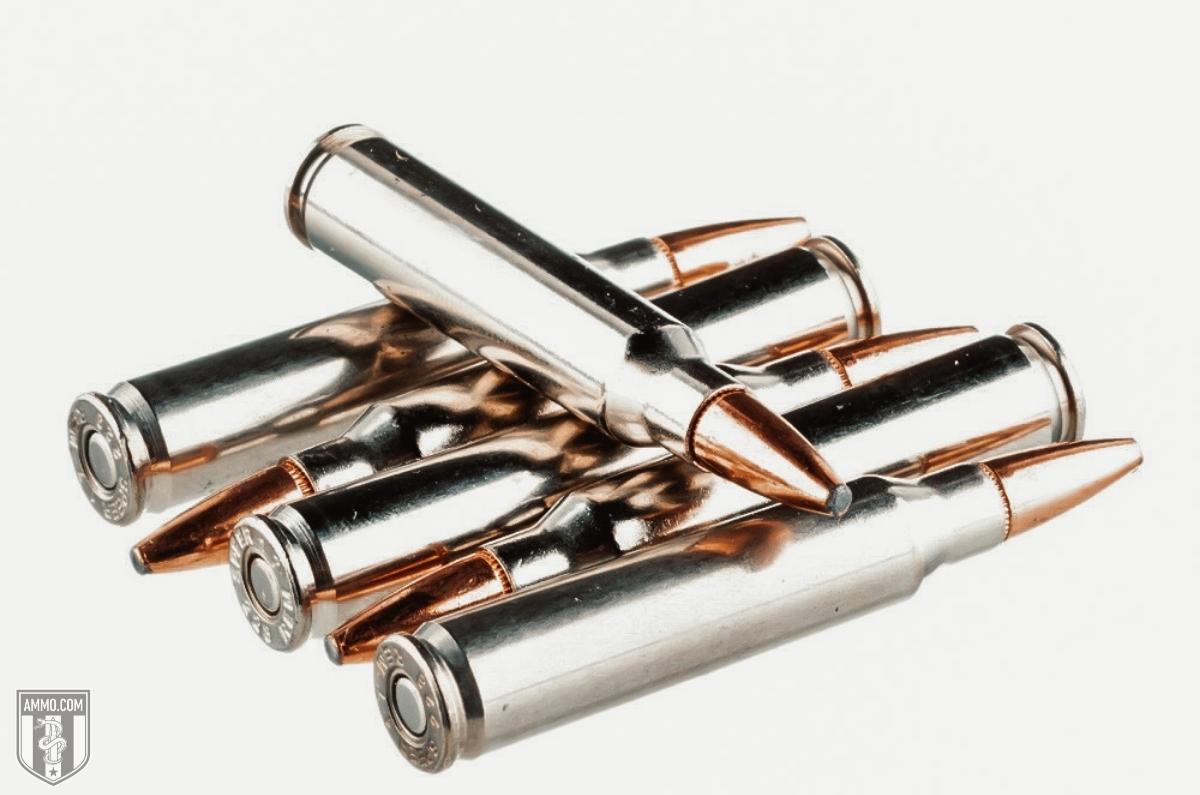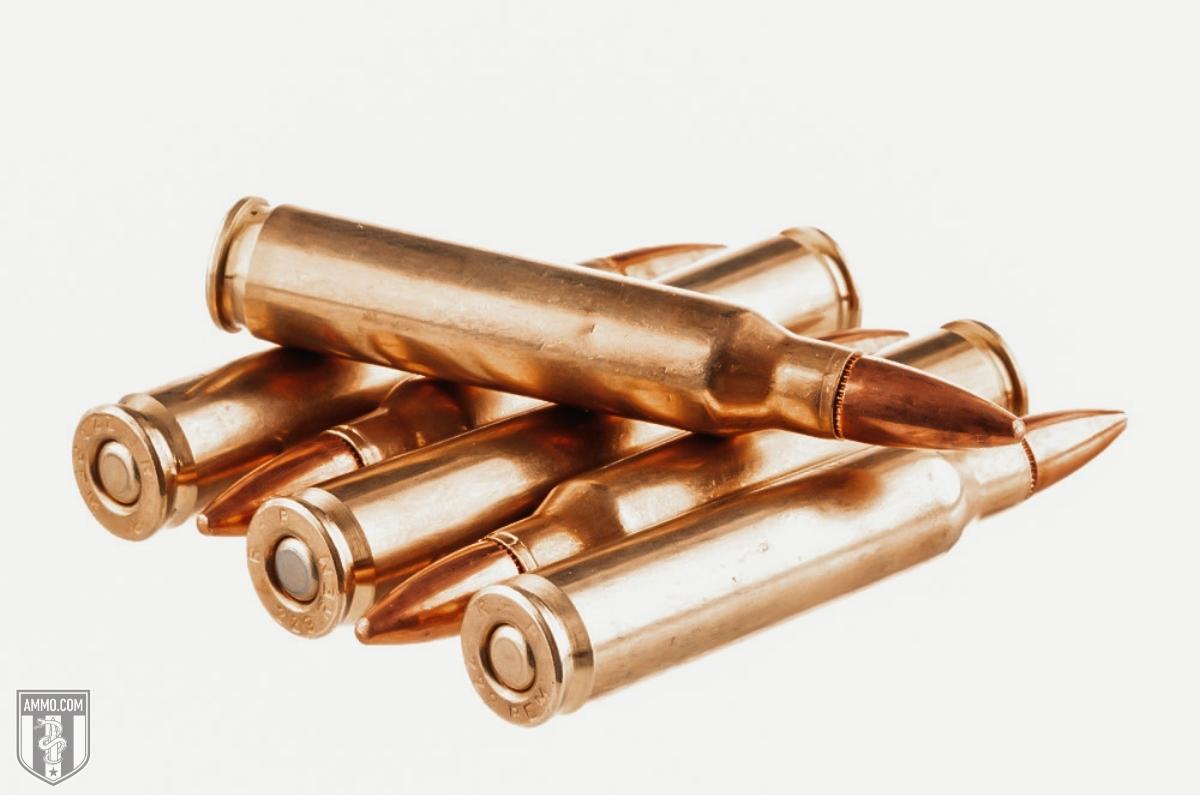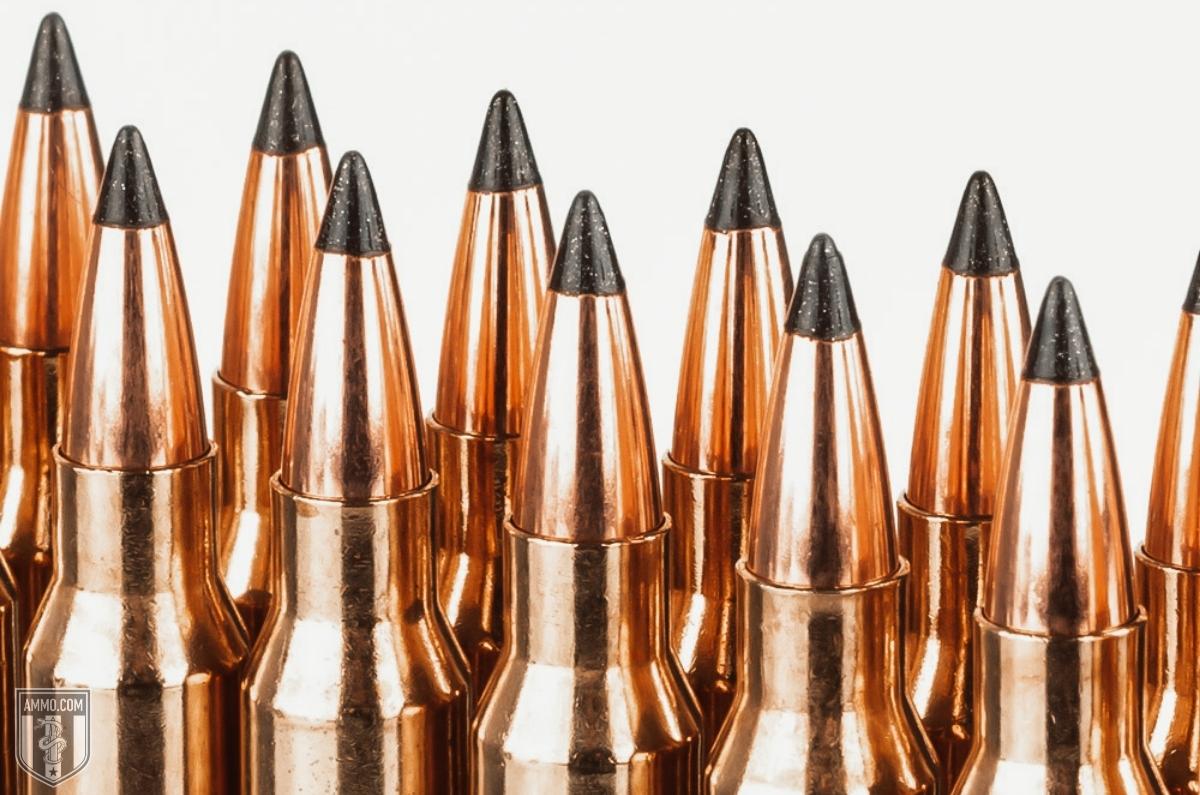450 Bushmaster vs 223: Big Bore or Classic Black Rifle?
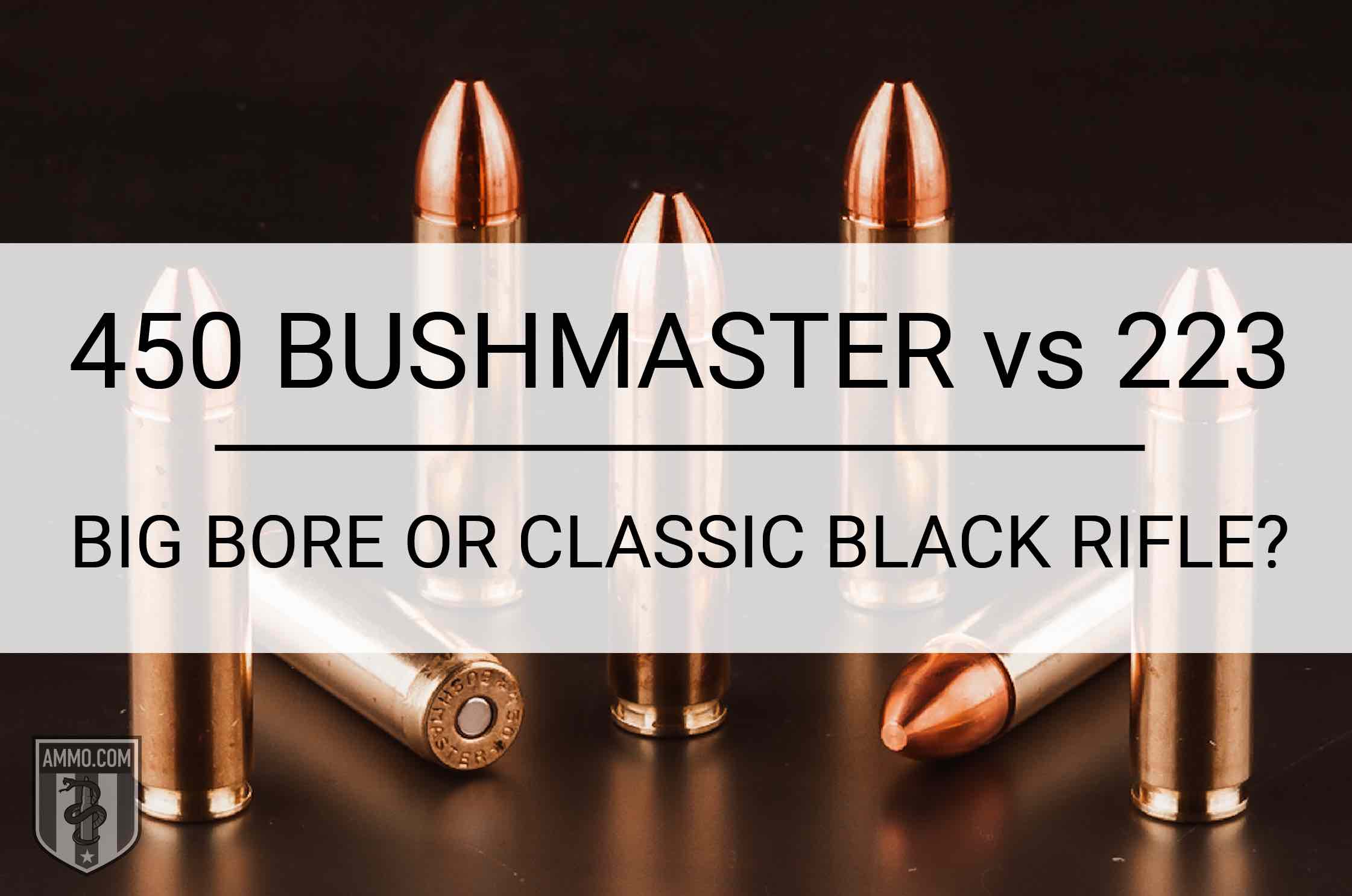 The 223 Remington and 450 Bushmaster are two centerfire rifle cartridges that couldn’t be more dissimilar from each other, except that they are fired from the most popular semi-automatic rifle in North America…The AR-15.
The 223 Remington and 450 Bushmaster are two centerfire rifle cartridges that couldn’t be more dissimilar from each other, except that they are fired from the most popular semi-automatic rifle in North America…The AR-15.
Although the 223 Remington has seen widespread success as a varmint round, some hunters wanted to use their semi-auto AR platform rifles to hunt whitetail, hogs, and other medium to large sized game animals.
Sadly the 223 Remington is not an approved cartridge for deer hunting in most states and territories, but many shooters still wanted a semi-automatic hunting rifle that wouldn’t break the bank.
Enter the 450 Bushmaster, which allowed deer hunters to convert their AR-15 carbine into a whitetail slaying machine simply by changing its barrel, bolt, and magazine follower.
But is it worth converting your AR-15 to the relatively new 450 Bushmaster, or would you be better served by sticking with the tried-and-true 223 Rem?
In this article, we will analyze the differences between the 450 and the 223 so that you can make a more informed decision on your next hunting rifle.
What is the difference between 450 Bushmaster and 223?
The major difference between the 450 Bushmaster and the 223 is that the 450 Bushmaster fires a 0.452” diameter bullet compared to 0.224” for the 223 Remington. Furthermore, the 223 uses a bottle-necked case design while the 450 Bushmaster is a straight-walled cartridge.
A Note on Nomenclature
Please note that within this article we will refer to the 223 Remington (223 Rem) and the 5.56x45mm NATO round interchangeably. There are differences between the two and you can read about them in this article: .223 vs 5.56
In short, a 223 Rem can safely be fired from a rifle or handgun chambered in 5.56, however the opposite is not true.
Cartridge Specs
When evaluating centerfire cartridges, it’s a good idea to analyze the cartridge specs to gain more knowledge of each.
The biggest difference between the 450 Bushmaster and the 223 Rem is the case design, as the 450 uses a straight-walled case compared to a bottle-necked case for the 223. Although the bottle-neck design is considered more efficient as it allows cartridges to have increased case capacity, they are not legal for deer hunting in some midwestern states. Hunting regulations in Iowa and Ohio as well as parts of southern Michigan and public land in Indiana require the uses of straight-walled cartridges.
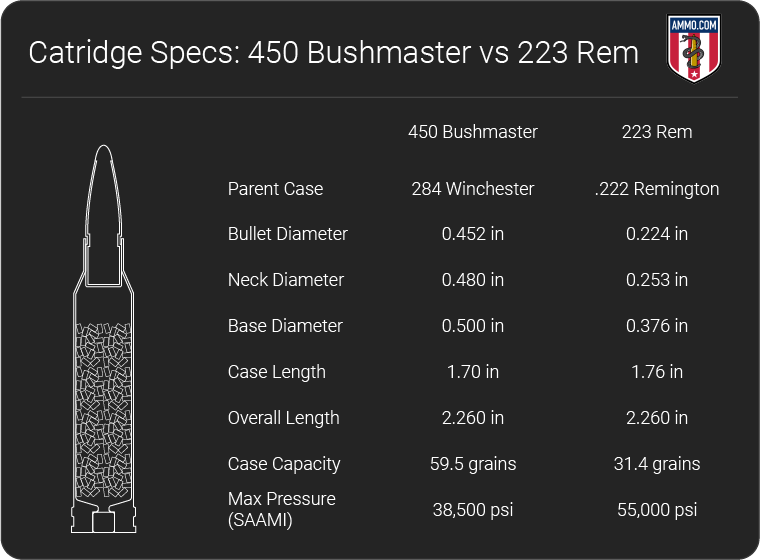
The second major difference between 450 Bushmaster and 223 is the bullet diameter that each cartridge fires. The 223 fires a 0.224” diameter bullet while the 450 Bushmaster fires a 0.452” bullet.
The 450 Bushmaster generally fires bullets between 158 and 300 grains, with the 250 gr and 260 gr loadings being the most popular. In contrast, the 223 generally fires bullets between 35 and 77 grains, with the 55 and 62 gr loads being the most popular.
The 223’s case length is virtually identical to the 450 Bushmaster. This is primarily due to the requirement that the both hunting cartridges need to fit into standard AR-15 magazines which allow for a maximum overall length of 2.26”. However, the 223’s case length is slightly longer at 1.76” compared to 1.70” for the 450 Bushmaster.
The case capacity of the 450 surpasses the 223 by a considerable margin, as the 450 Bushmaster can hold 59.5 gr of propellant compared to 31.4 gr for the 223.
The final major difference between the two rifle cartridges is the maximum pressure that each round can accommodate. SAAMI specifies that the 223 can handle a whopping 55,000 psi compared to 38,500 psi for the 450 Bushmaster. Straight-walled cartridges generally have lower chamber pressure due to their design, but 450 needs to have lower pressure due to the AR-15 recoil system. The 450 Bushmaster is a powerful round and thusly has significantly more recoil than a 223. This causes considerably more bolt thrust being exerted on the recoil buffer and spring when firing a 450. As such, if this round had any more pressure, there is the potential that the rifle could be damaged.
Recoil
When it comes to low recoil, the 223 Remington is the unequivocal winner.
Recoil is a combination of 3 primary factors: rifle weight, powder charge, and bullet weight. Taking these considerations to mind, it’s clear why the 223 has lower recoil as it has a lower powder charge and bullet weight compared to the 450 Bushmaster.
Felt recoil will differ between shooters, stance, and rifle choice.
Although there is a wide range of bullet weights for 223 Rem, on average the 223 will have around 4 ft-lbs of recoil energy compared to approximately 24 ft-lbs for 450 Bushmaster.
To put this into context, the 450 Bushmaster only has 3 ft-lbs less free recoil than a 2 ¾” 12-gauge shotgun shell firing 1 oz slugs. That’s quite a lot of kick for an AR-15, though it can be somewhat mitigated with the use of a muzzle brake.
Muzzle Velocity and Kinetic Energy
The 223 Remington and 450 Bushmaster are two rifle cartridges that utilize two distinct methods for achieving effective terminal ballistic performance.
The 223 operates under the concept of “speed kills” and uses a very light bullet weight fired at an extremely high muzzle velocity to cause bullet cavitation and hydrostatic shock. In contrast, the 450 Bushmaster utilizes the “big bullets make big holes” concept of terminal ballistics with high muzzle energy to hit the target as hard as possible.
For the purpose of this comparison, we will consider the 223 Rem Hornady V-MAX with a 55 grain bullet compared to the Hornady 250 gr FTX for 450 Bushmaster.
The 55 gr V-MAX has a muzzle velocity of 3,240 fps and 1,282 foot-pounds of energy compared to 2,200 fps and 2,686 foot-pounds of energy for the 250 gr FTX 450 Bushmaster bullet.
The 223 round has over 1,000 fps more muzzle velocity while the 450 Bushmaster has nearly 1,400 ft-lbs more muzzle energy.
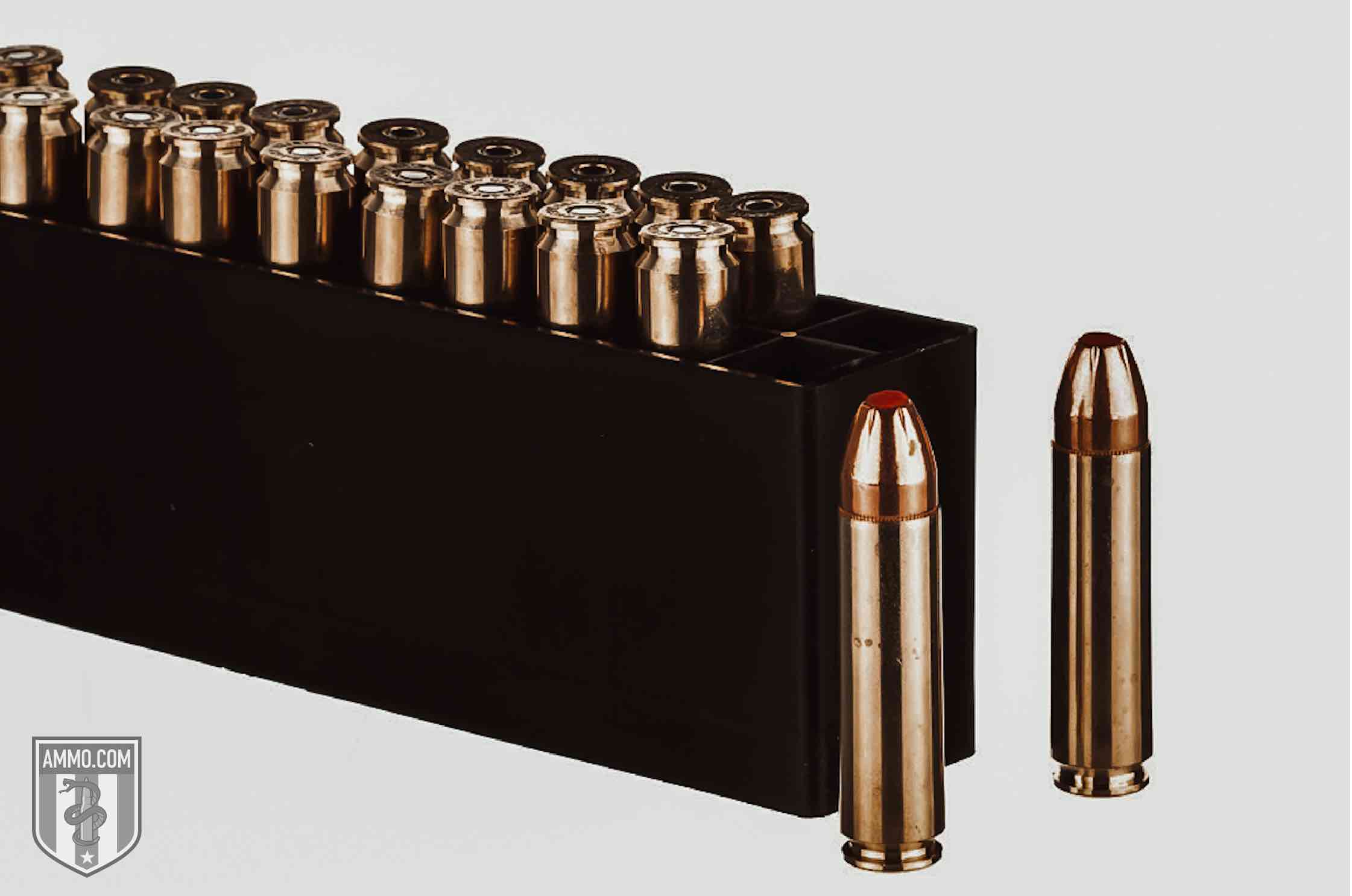
Also keep in mind that muzzle velocity and muzzle energy are dependent on barrel length. Most manufacturer’s ballistic data for their factory loads come from a 20-24 inch barrel. As many AR-15 rifles come with a carbine (16”) or mid-length barrel (18”), understand that the listed ballistic performance may differ in your rifle based on its barrel length.
Trajectory
Trajectory is how we quantify a bullet’s flight path as it travels downrange measured in inches of bullet drop.
Obviously, a flatter shooting cartridge is preferred for long-range shooting, as a shooter will require fewer adjustments to their optics to compensate for bullet drop. Having a flatter trajectory also means that a cartridge will be more forgiving of ranging mistakes.
The 223 Rem dominates in the trajectory category as it is firing a lighter bullet at higher muzzle velocities. This means that gravity will have less time to affect the bullet’s flight.
For the aforementioned Hornady factory loads, assuming a 100-yard zero, the 223 Rem will have experienced -11” of bullet drop at 300 yards compared to -33” for the 450 Bushmaster at the same range.
The flat trajectory of the 223 gives it an effective range of over 600 yards on smaller game animals while the 450 Bushmaster cartridge is typically considered as having a maximum effective range of 250 yards for big game hunting.
Ballistic Coefficient
Ballistic coefficient (BC) is a measure of how well a bullet resists wind drift and air resistance. Put another way, it’s a numeric representation of how aerodynamic a bullet is. A high BC is preferred as this means the bullet will buck the wind easier.

Generally, heavy bullets will have a higher BC as it takes more force to disrupt the flight of a heavier bullet than a lighter one. Ballistic coefficient varies from bullet to bullet based on design, weight, and other factors that are beyond the scope of this article.
Although the 450 Bushmaster will always fire a heavier bullet than the 223 Rem, the 223 will often have the better BC due to its more aerodynamic design.
The design of the 450 Bushmaster bullets is relatively inefficient, wide, and more susceptible to wind.
Although BC will vary between bullets and manufacturers, most 223 ammo will have a ballistic coefficient around 0.255 while the 450 has a BC of 0.210.
To illustrate this, we can look at wind drift data to get an idea of how well each bullet bucks the wind. Introducing a 10 mph crosswind, we see that the 55 gr V-MAX will experience around 7” of wind drift at 250 yards compared to 16” for the 450 Bushmaster.
Sectional Density
Sectional Density (SD) is the measure of how well a bullet penetrates a target. This is extremely important when hunting big and medium sized game, as you need a bullet that can punch through thick hide, bone, and sinew.
Sectional density is calculated by comparing the bullet weight and the bullet diameter. The higher the SD the deeper the bullet will penetrate into the target. This is a simplified view of penetration as there are other factors to consider, such as bullet expansion and high velocity.
Both rifle cartridges have excellent penetration as they are designed as hunting rounds. The 223 focuses all of its energy into a small point while the 450 Bushmaster uses raw bone crushing power to punch deep into its intended target.
Although it might make more sense that the 223 would have deeper penetration due to its small size and high muzzle velocity, it is the 450 Bushmaster that has higher sectional density.
The 450 Bushmaster has a SD of 0.175 compared to 0.157 for 223. This means that the 450 will generally penetrate deeper, which is ideal for hunters who need their bullets to punch through thick hide, bone, and sinew.
Hunting
Both the 223 and 450 Bushmaster are excellent options for hunting game animals that are appropriately sized for each cartridge.
The 223 is well known for its varmint hunting prowess. From groundhogs to coyotes, the 223 is an excellent option for a lightweight, low recoil, semi-automatic varmint rifle.
On the other hand, the 450 Bushmaster is an excellent choice when you want to go big game hunting. With enough foot-pounds of energy to take down an elk at 100 yards, the 450 is a great choice when you want to fix your sights on whitetail, hogs, elk, and even black bear.
As the 450 Bushmaster is a straight-walled cartridge, it is legal for use in Midwest states like Indiana, Ohio, Michigan, and Illinois that require the use of such cartridges each deer season. Although the 450 Bushmaster does have some competition in this realm, the 350 Legend and 50 Beowulf primarily, the 450 is still the top choice for deer hunters who want to utilize their AR-15 platform for deer hunting instead muzzleloaders.
The only downside to the 450 Bushmaster for whitetail hunting is its limited effective range. Due to its rapid hemorrhaging of kinetic energy and muzzle velocity after firing, the 450 Bushmaster has an effective range of around 250 yards on deer. For most hunters, this is not an issue as they are hunting in thick brush or heavily wooded areas. However, if a long-range shots will be taken, it would be advisable to switch to something along the lines of a 308 Winchester, 30-06 Springfield, or 6.5 Creedmoor as these cartridges can maintain the kinetic energy needed to harvest a deer at longer ranges.
The 450 Bushmaster offers hunters a lightweight, compact hunting rifle option that packs a huge punch at short distances. High quality factory ammo can produce MOA to sub-MOA levels of accuracy, making the 450 Bushmaster an excellent option for hunters in cartridge-restrictive states.
Ammo and Rifle Cost/Availability
The 223 Remington is one of the most popular centerfire rounds in North America and cannot be beaten in terms of ammo and rifle options.
Virtually every ammo manufacturer like Federal, Remington, Barnes, Hornady, and Underwood has multiple 223 options available to suit all of your hunting and long range shooting needs. Furthermore, as the 223 Rem is a military caliber (5.56x45mm NATO), you can find surplus ammo and brass relatively easily.
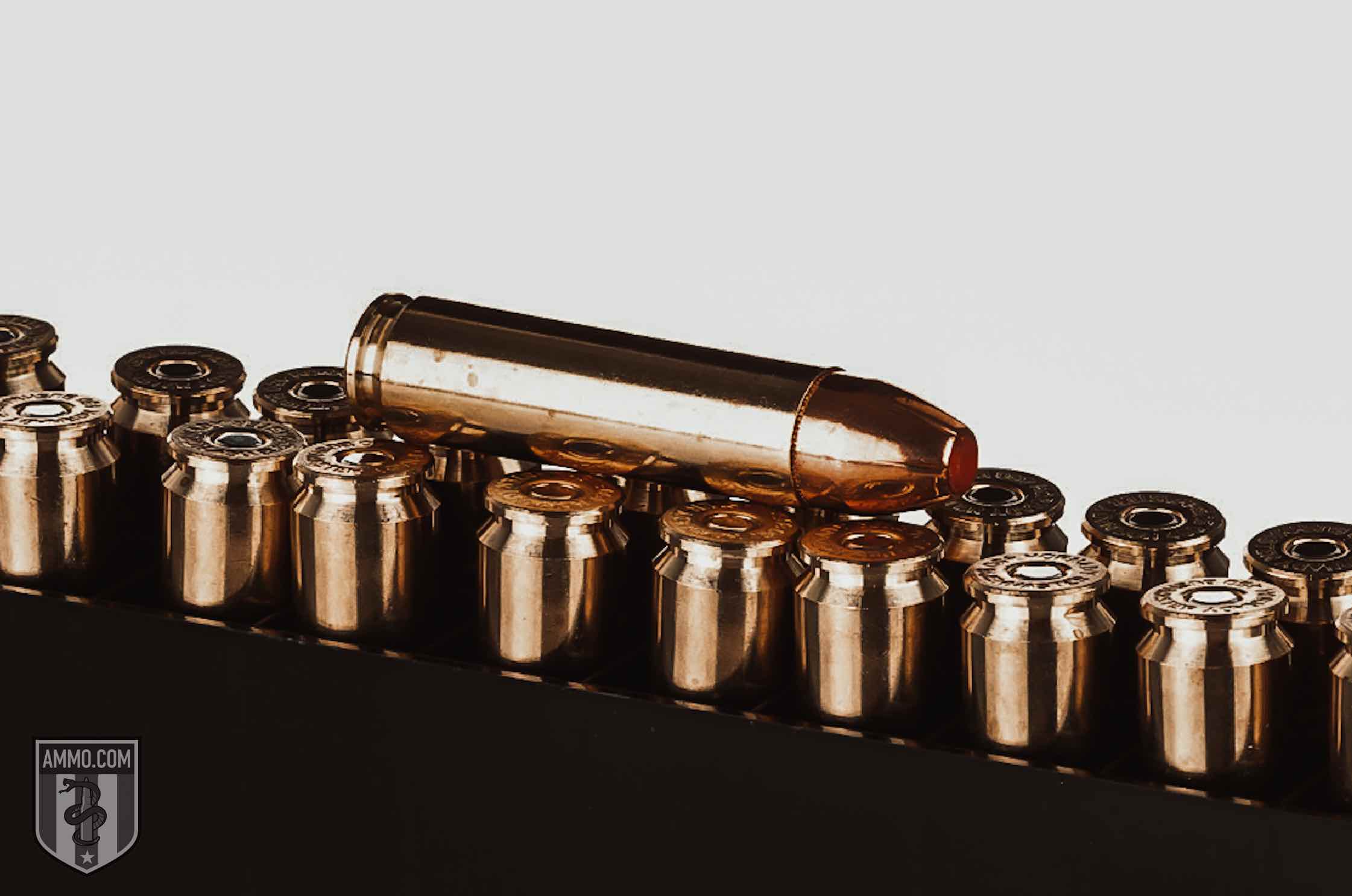
On average, inexpensive fmj practice ammo runs around $0.45/round while premium hunting ammo starts around $1.20/round and can go up from there depending on the manufacturer.
Comparatively, 450 Bushmaster ammo is more expensive. Practice fmj ammo starts around $1.50/round while hunting ammo goes for no less than $2.50/round.
It’s also important to note that you should have virtually no issues sourcing 223 ammo, as it can be found in virtually every sporting goods store and gun store, whereas 450 Bushmaster might be a bit more difficult to source locally.
As far as ammo variety is concerned, the 223 has about a 8:1 advantage over 450 due to its massive popularity.
Buying in bulk is always smart, make sure to check out our stock of 223 bulk ammo and 5.56 bulk ammo.
In terms of rifles, the 223 is undeniably the more prolific option. There are bolt-action rifles galore when it comes to 223 from manufactures like Marlin, Winchester, Remington, Savage, Ruger, Sako, and Browning. As far as semi-automatic options are concerned, the AR-15 is the most popular sporting rifle in the world and virtually every rifle manufacturer has their own take on the AR platform. Outside of the AR-15, there are several other 223 semi-auto options such as the Ruger Mini-14, the IWI Tavor, and Kel-Tec RDB.
For the 450 Bushmaster, any AR-15 you have in your collection is a potential host for the cartridge. All that is needed is a new barrel, bolt, and single-stack magazine follower. Or you could take the easier route and use a dedicated 450 Bushmaster upper receiver. This way, you could just swap between your 223 upper and Bushmaster upper whenever you wanted to change caliber (just make sure to ensure you’re firing the right ammo through the correct upper receiver!)
There are other options available for the 450 Bushmaster as well, such as a Henry single shot rifle or the Ruger American Ranch or Savage 110 if you prefer a bolt-action. Although these rifles will serve you well, they seem to be a bit of disservice to the cartridge as it was built for use in the semi-auto AR-15. However, if your state restricts hunting to bolt-action rifles, then these would be excellent options.
Neither cartridge is well suited for use in a lever-action rifle due to the pointed bullets each fire.
Although the 450 Bushmaster is becoming a more common caliber to see during deer season, it cannot keep up with the popularity and availability of the 223 Rem at this time.
Reloading
If you enjoy making your own handloads, then both the 223 and 450 Bushmaster are right up your alley.
The 223 Rem in particular is a joy to reload as there are a plethora of 0.224” diameter bullets available to customize your hunting or target ammo to your exact specifications. Furthermore, there are tons of powders available that are suitable for 223 reloading at your disposal. Brass is easy to find and inexpensive as there are many suppliers of once-fired military or civilian range brass at your disposal.
When it comes to the 450 Bushmaster, the fact that it is a straight-walled cartridge is a real blessing as these are simpler to resize than bottlenecked cartridges.
There are plenty of bullets available in 45-caliber, however you need to ensure that you order the correct bullet size as there are some variations. For rifle bullets, 45-caliber is typically 0.458” in diameter for cartridges like the 458 SOCOM. Furthermore, 0.454” diameter is available for handgun rounds like the 454 Casull. These bullets should be avoided as 450 Bushmaster requires the 0.452” diameter bullets.
Care needs to be taken when reloading for the 450, as excess pressure can cause problems with the AR-15 gas system. Therefore, it is advisable to never exceed published maximum loads as the 450 can be pressure sensitive. In addition, if you are using a roll crimp on a 450 round with a bullet cannelure, it is advisable to use a very minor crimp to minimize any additional pressure that could accompany a heavy crimp.
223 Remington Ballistics
Note: This information comes from the manufacturer and is for informational purposes only. The actual ballistics obtained with your firearm can vary considerably from the advertised ballistics. Also, ballistics can vary from lot to lot with the same brand and type load.
| 223 Bullet WEIGHT | Muzzle VELOCITY (fps) | Muzzle ENERGY (ft. lbs.) | TRAJECTORY (in.) | |||||||||||
|---|---|---|---|---|---|---|---|---|---|---|---|---|---|---|
| Muzzle | 100 yds. | 200 yds. | 300 yds. | 400 yds. | Muzzle | 100 yds. | 200 yds. | 300 yds. | 400 yds. | 100 yds. | 200 yds. | 300 yds. | 400 yds. | |
| 35 Grain | 3750 | 3206 | 2725 | 2291 | 1899 | 1092 | 799 | 577 | 408 | 280 | 1 | 0 | -5.7 | -18.1 |
| 35 Grain | 4000 | 3353 | 2796 | 2302 | 1861 | 1243 | 874 | 607 | 412 | 269 | 0.8 | 0 | -5.3 | -17.3 |
| 40 Grain | 3650 | 3010 | 2450 | 1950 | 1530 | 1185 | 805 | 535 | 340 | 265 | 2 | 1 | -6 | -22 |
| 40 Grain | 3800 | 3305 | 2845 | 2424 | 2044 | 1282 | 970 | 719 | 522 | 371 | 0.84 | 0 | -5.34 | -16.6 |
| 45 Grain Green | 3550 | 2911 | 2355 | 1865 | 1451 | 1259 | 847 | 554 | 347 | 210 | 2.5 | 2.3 | -4.3 | -21.1 |
| 50 Grain | 3300 | 2874 | 2484 | 2130 | 1809 | 1209 | 917 | 685 | 504 | 363 | 1.37 | 0 | -7.05 | -21.8 |
| 52 Grain | 3330 | 2882 | 2477 | 2106 | 1770 | 1305 | 978 | 722 | 522 | 369 | 2 | 0.6 | -6.5 | -21.5 |
| 53 Grain | 3330 | 2882 | 2477 | 2106 | 1770 | 1305 | 978 | 722 | 522 | 369 | 2 | 0.6 | -6.5 | -21.5 |
| 55 Grain Green | 3240 | 2747 | 2304 | 1905 | 1554 | 1282 | 921 | 648 | 443 | 295 | 1.9 | 0 | -8.5 | -26.7 |
| 55 Grain | 3240 | 2748 | 2305 | 1906 | 1556 | 1282 | 922 | 649 | 444 | 296 | 2 | -0.2 | -9 | -27 |
| 60 Grain | 3100 | 2712 | 2355 | 2026 | 1726 | 1280 | 979 | 739 | 547 | 397 | 2 | 0.2 | -8 | -24.7 |
| 62 Grain | 3000 | 2700 | 2410 | 2150 | 1900 | 1240 | 1000 | 800 | 635 | 495 | 1.6 | 0 | -7.7 | -22.8 |
| 64 Grain | 2750 | 2368 | 2018 | 1701 | 1427 | 1074 | 796 | 578 | 411 | 289 | 2.4 | 0 | -11 | -34.1 |
| 64 Grain | 3020 | 2621 | 2256 | 1920 | 1619 | 1296 | 977 | 723 | 524 | 373 | 2 | -0.2 | -9.3 | -23 |
| 64 Grain | 3020 | 2621 | 2256 | 1920 | 1619 | 1296 | 977 | 723 | 524 | 373 | 2 | -0.2 | -9.3 | -23 |
| 69 Grain | 3000 | 2720 | 2460 | 2210 | 1980 | 1380 | 1135 | 925 | 750 | 600 | 2 | 0.8 | -5.8 | -17.5 |
| 75 Grain | 2790 | 2554 | 2330 | 2119 | 1926 | 1296 | 1086 | 904 | 747 | 617 | 2.37 | 0 | -8.75 | -25.1 |
| 75 Grain | 2790 | 2562 | 2345 | 2139 | 1943 | 1296 | 1093 | 916 | 762 | 629 | 1.5 | 0 | -8.2 | -24.1 |
| 75 Grain | 2790 | 2562 | 2345 | 2139 | 1943 | 1296 | 1093 | 916 | 762 | 629 | 1.5 | 0 | -8.2 | -24.1 |
| 75 Grain Super Match | 2930 | 2694 | 2470 | 2257 | 2055 | 1429 | 1209 | 1016 | 848 | 703 | 1.2 | 0 | -6.9 | -20.7 |
| 77 Grain | 2750 | 2584 | 2354 | 2169 | 1992 | 1293 | 1110 | 948 | 804 | 679 | 1.93 | 0 | -8.2 | -23.8 |
A Brief History of 450 Bushmaster
The 450 Bushmaster was released in 2007 by Tim LeGendre of LeMAG Firearms based around the “Thumper concept” put forth by the late and great Lt. Col. Jeff Cooper. Cooper appreciated the utility and flexibility of the AR platform but was unimpressed with the ballistic performance of the 5.56x45mm NATO (223 Rem).
His “Thumper concept” was a new cartridge designed to be fired from the semi-auto AR-15, had an effective range around 250 yards, was 44-caliber or larger, and could harvest large game with one shot. Tim LeGendre was inspired by Cooper’s concept and began development of a new round that met his specifications.
LeGendre used a .284 Winchester as the parent case for the design and dubbed the new cartridge the 45 Professional. The design was then licensed to Bushmaster who then collaborated with Hornady to manufacture ammo for the new concept.
Hornady requested that the case be shortened slightly to accommodate their 250 SST bullet. This change was accepted by Bushmaster and LeGendre, thusly the cartridge was renamed the 450 Bushmaster (450 BM for short) and released in 2007.
The 450 Bushmaster is one of the most successful Thumper rounds, followed closely by the 458 SOCOM and 50 Beowulf, boasting the most factory ammo options of the 3 rounds. Its bone shattering 2,200 fps and 2,700 ft-lbs of energy is extremely popular with feral hog and deer hunters for its impressive terminal ballistics and semi-automatic capabilities.
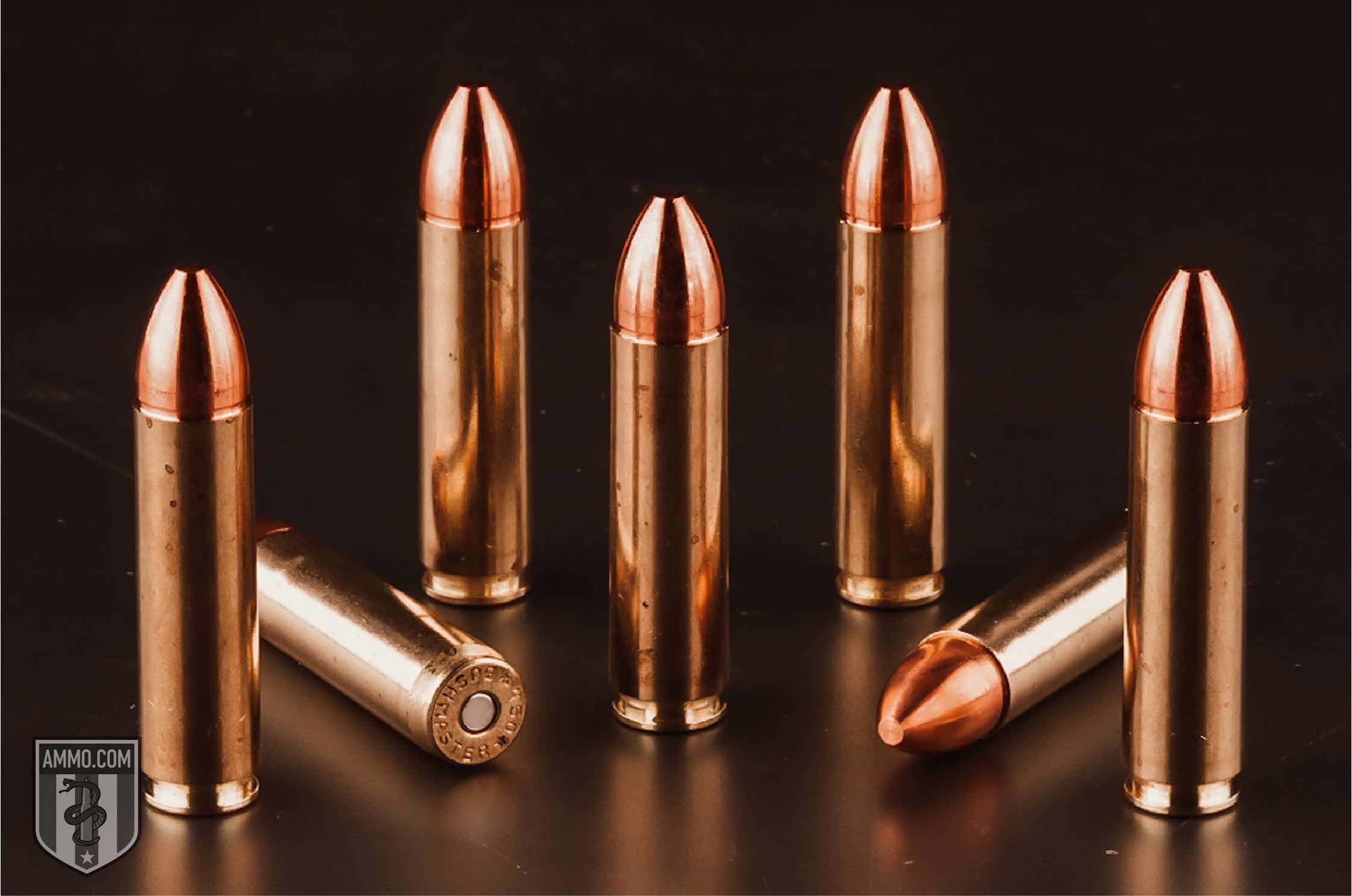
Dedicated 450 Bushmaster AR uppers are currently available but converting your AR-15 to 450 Bushmaster only requires a new barrel, bolt, and single-stacked magazine follower for your standard 5.56 NATO magazines.
Although the 450 Bushmaster is still a relatively new cartridge on the market, it is quickly gaining ground as one of the most popular Thumper Rounds available today.
If you’d like to learn more about how the 450 Bushmaster compares to other calibers, check out these articles below:
A Brief History of 223 Remington
Development of the 223 Remington rifle round began in 1957 and the final design was submitted by Remington Arms to the Sporting Arms and Ammunition Manufacturers' Institute (SAAMI) in 1962.
The development of the 223 Remington cartridge was a joint operation organized by the U.S. Continental Army Command between Fairchild Industries, Remington Arms, and Eugene Stoner of Armalite, using the 222 Remington as a parent cartridge.
The 222 Remington case was elongated 0.06” and the neck was shortened. These changes allowed for the new 223 Remington ammunition to have a 20% larger powder charge than its progenitor.
Eugene Stoner was the primary inventor of the AR-10 rifle (chambered in 7.62x51 NATO), which he was invited to scale down to accommodate the new .223 Rem cartridge.
The resulting rifle that the military accepted was the M16, the civilian version being the AR-15. Since adoption, the AR-15 carbine has become the most popular sporting rifle in US history.
With its lightweight and low recoil, the M16 is an ideal platform for full auto fire and the ammo is considerably lighter than its 308 Winchester counterpart. This allows soldiers to carry more ammo into battle for the same weight, meaning they can stay in the fight longer without impeding their mobility.
Since then, the M16 and the shorter barrel length M4 Carbine have become a ubiquitous symbol of American military prowess across the globe.
The original 223 Rem mil-spec ammo that the U.S. Military adopted was named M193, which fired a 55 gr full metal jacket (FMJ) bullet at a muzzle velocity of 3240 FPS with a muzzle energy of 1282 foot-pounds.
The new 223 Remington cartridge had sufficient long range capability out to 500 yards while maintaining accuracy and offers bullet weights between 35 and 77 grains.
The 223 Rem was released to the civilian market one year before adoption by the U.S. Army, and varmint hunters enjoyed the new cartridge’s low recoil, extreme accuracy, and lower pressure.
It was not long before all the major firearm manufacturers offered semi-auto and bolt action rifle in the new 223 Remington cartridge.
To read more about the 223 Remington, check out the full history of the cartridge on our 223 Remington history page.
If you’d like to learn more about how the 223 Rem compares to other calibers, check out these articles below:
Final Shots: 450 Bushmaster vs 223
The 223 and 450 Bushmaster are two centerfire rifle cartridges that are optimized for the AR-15 rifle. However, this is where the similarities end as the 223 and 450 couldn’t be more dissimilar from one another.
The 223 Remington is the cartridge of choice for the US Military and has served in the M16/M4 carbine since the Vietnam War. It has proven itself on the front lines as well as in the woods as a potent varmint round with low recoil and a wide variety of inexpensive rifles and ammo to choose from.
The 450 Bushmaster is a relatively new cartridge that looks to increase the terminal ballistics of the AR-15 rifle to make it suitable for whitetail and other big game. It’s a big bore round with a massive amount of kinetic energy that aims to drop game animals with one shot inside 250 yards.
Although the 450 Bushmaster cartridge is relatively inefficient compared to other popular hunting rounds like the 30-06 Springfield, the 450 satisfies the straight-walled cartridge requirement in Midwest states like Michigan and Ohio. This allows hunters in those states to use their AR-15 platform for hunting whitetail when they would otherwise be limited to muzzleloaders or shotguns.
The question of 223 vs 450 Bushmaster really comes down to determining what you want to do with the rifle. If you want an inexpensive plinker that has the power to defend freedom and not break the bank, then go with 223. On the other hand, if you need a 450 Bushmaster to hunt in your state or you just love the concept of the 450, then there’s no reason not to get one.
Having a dedicated 450 Bushmaster upper is a great compromise, as it allows you to switch between two calibers by simply pushing out two pins and changing your magazine.
However, if you can only pick one, then I must lean on the popularity of the 223 Remington as it is less expensive to shoot and considerably easier to find ammo for.
Regardless of your choice, make sure you get all of your ammo here at Ammo.com and get out to the range and practice those marksmanship skills!
Ammo Comparisons
- .308 vs 5.56
- 6.5 Creedmoor vs .308
- .300 Blackout vs .308
- .300 Win Mag vs .308
- .243 vs .308
- .308 vs .30-06
- 7mm-08 vs .308
- .270 vs .308
- 7.62x39 vs .308
- .223 vs .308
- .338 Lapua vs .308
- .380 ACP vs 9mm
- .223 vs 5.56
- .300 Blackout vs 5.56
- 9mm vs 45 ACP
- 9mm vs 40 S&W
- .357 SIG vs 9mm
- 10mm vs 9mm
- 9mm vs 9mm Luger
- .243 vs .270
- .300 Win Mag vs .30-06
- .270 vs .30-06
- .40 vs .45
- 38 Special vs 357
- 9mm vs 40 vs 45
- 5.56 vs 7.62x39
- 338 Lapua vs .30-06
- .30-30 vs .30-06
- 300 PRC vs 338 Lapua
- .30-06 vs 7mm
- 300 Win Mag vs 338 Lapua
- 300 PRC vs 300 Win Mag
- 300 WSM vs 300 Win Mag
- 338 Win Mag vs 338 Lapua
- 12 Gauge vs 20 Gauge
- 10mm vs 357 Mag
- .30-30 vs 7.62x39
- 224 Valkyrie vs 22-250
- 17 HMR vs 22 Mag
- 7.62x39 vs .300 Blackout
- 45 ACP vs 45 Auto
- 45-70 vs 30-30
- 300 Blackout vs 223
- 357 Magnum vs 9mm
- 350 Legend vs 300 Blackout
- 224 Valkyrie vs 223
- 45 ACP vs 38 Super
- 6.5 Grendel vs .308
- 17 HMR vs 22 LR
- 10 Gauge vs 12 Gauge
- 22-250 vs 223
- 45 Colt vs 45 ACP
- 350 Legend vs 30-30
- 5.7x28 vs 223
- 5.7 vs 9mm
- 5.56 vs 5.7
- 22 vs 9mm
- Buckshot vs Birdshot
- 450 Bushmaster vs 308
- 450 Bushmaster vs 223
- Buckshot vs Slug
- 6.5 Grendel vs 5.56 vs 223
- 6mm ARC vs 6.5 Grendel
- 44 vs 45
- 458 SOCOM vs 5.56
- 357 vs 44
- 32 ACP vs 380
- 300 Win Mag vs 338 Win Mag vs 338 Lapua Mag
- 450 Bushmaster vs 458 SOCOM vs 50 Beowulf
- 6mm Creedmoor vs 6.5 Creedmoor
- TMJ vs FMJ
- 44 Special Vs 44 Magnum
- 45 90 vs 45 70
- 6.8 Western vs 6.8 SPC
- 50 Beowulf vs 50 BMG
- 26 Nosler vs 6.5 PRC
- 28 Gauge vs 410
- 6.8 SPC vs 5.56
- 6.8 SPC vs 6.5 Grendel
- 6.8 Western vs 7mm Rem Mag vs .28 Nosler
- 6.8 Western vs 6.5 Creedmoor
- 22 Hornet vs 223
- 6.8 Western vs 6.5 PRC
- .410 vs 12 Gauge
- .410 vs 20 Gauge
- 22 LR vs 22 Mag
- 6mm ARC vs 243
- 7mm-08 vs 270
- 243 vs 6.5 Creedmoor
- Nickel vs Brass Casing
- 204 Ruger vs 223
- 50 Beowulf vs 5.56
- 260 Remington vs 6.5 Creedmoor
- 6mm Remington vs 243
- 28 Nosler vs 300 PRC
- 50 Beowulf vs 50 AE
- 22 Nosler vs 22-250
- 450 Marlin vs 45-70
- 300 Win Mag vs 300 Norma
- 458 SOCOM vs 300 Blackout
- 38-55 vs 45-70
- 22 Hornet vs 22 LR
- 300 Norma vs 338 Lapua
- 338 Lapua vs 50 BMG
- 28 Nosler vs 300 Win Mag
- 28 Nosler vs 6.5 Creedmoor
- 204 vs 22-250
- 458 SOCOM vs 45 70
- 44 40 vs 45 70
- 6.8 SPC vs 6.5 Creedmoor
- 450 Bushmaster vs 30-06
- 7mm Rem Mag vs 300 Win Mag
- 30 Carbine vs 223
- 25-06 vs 30-06
- 26 Nosler vs 28 Nosler
- 16ga vs 12ga
- 30 06 vs 7.62 x54R
- 9mm Makarov vs 9mm Luger
- 350 Legend vs 223
- 30 Carbine vs 5.56
- 6.5x55 vs 6.5 Creedmoor
- 6.5 Creedmoor vs 270 vs 25-06
- M193 vs M855
- 450 Bushmaster vs 458 SOCOM
- 6.5 Grendel vs 6.5 Creedmoor
- 350 Legend vs 5.56
- .277 Fury vs 6.8 SPC
- 277 Fury vs 300 Win Mag
- 10mm vs .45 ACP
- 277 Fury vs 223
- 6.8 SPC vs 300 Blackout
- 6.5 PRC vs 6.5 Creedmoor
- 277 Fury vs 308
- 277 Fury vs 6.5 Creedmoor
- 350 Legend vs 450 Bushmaster
- 277 Fury Vs 5.56 NATO
- 10mm vs 40S&W
- 32 ACP vs 9mm
- 32 Special vs 9mm
- 8.6 Blackout vs 300 Blackout
- 30 Super Carry vs. 9mm
- 5.56 vs 9mm
- .50 Action Express vs 9mm
- 7.62x25 vs. 9mm
- 10mm vs 44 Magnum
- 300 Blackout vs 300 Win Mag
- 6.5 Grendel vs 300 Blackout
- 460 Rowland vs 10mm
- 300 RUM vs 300 PRC
- 300 Norma vs 300 PRC
- 45 GAP vs 45 ACP
- 7mm PRC vs 300 Win Mag
- 300 PRC vs 6.5 Creedmoor
- 300 PRC vs 308
- 357 SIG vs 357 Mag
- 7.62x39 vs 7.62x51
- 243 Win vs 223 Rem
- 30 Nosler vs 300 PRC
- 6.5 Creedmoor vs. 30-06 Springfield
- 450 S&W vs. 44 Magnum
- 6.5 Creedmoor vs. 300 Win Mag
- 454 Cassull vs. 45-70 Govt
- 454 Cassull vs. 44 Mag
- 7.62x54r vs. 308 Winchester
- 22 ARC vs. 223 Rem
- Subsonic vs. Supersonic Ammo
